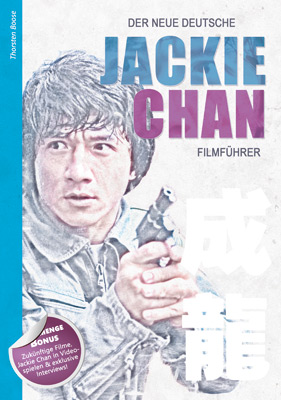
Not all cuts are the same: An interview about film versions with Schnittberichte.com
While researching my new book about the film legend Jackie Chan, “The new German Jackie Chan film guide”, I spoke to editors and authors of the German-language film website Schnittberichte.com, who in the past have devoted themselves to countless versions of Jackie Chan’s films.
Schnittberichte.com is one of the oldest German-language websites and is also the best place to go when it comes to cutting reports from different versions of films from all over the world. With passion and eagle eyes, the community of film buffs documents the differences very precisely and makes their knowledge available to fans free of charge.
For the first time, the founder and operator of Schnittberichte.com, Gerald Wurm, together with the hardest-working reviewer of Jackie Chan films, Muck47 (real name Tobias Maurer), reports on the work on cutting reports and their social status. This article contains a small excerpt from the interview, which can be read in its entirety in the book “The new German Jackie Chan film guide”.

Usually, audiences rarely care about the films they are enjoying, much less seeing them in different versions. How does such a documentation of a cutting report work? How much time do you invest per film and when are you satisfied?
Tobias Maurer: In the case of larger blockbusters, such backgrounds tend to be in the media, think for example of David Fincher’s dissatisfaction with the shooting of “Alien” and the correspondingly extensive director’s cut later.
First of all, an author finds out in some way about a particular film version and, depending on the circumstances, has a personal interest in documenting it more precisely. Over the years, the time required for individual components such as the version status (template errors, detailed interventions), basic text structure in the intro and descriptions of deviations, creation of screenshots, etc. But the first point in particular is always a lucky bag: 70s films tend to have more film tears in one or even both versions, which requires more detailed work, especially in the case of swallowed dialogues or shots.
In Chan films like “The Protector” or “Mr. Nice Guy” it also deceives a mere look at the running times of the versions. With only a very small difference, there are around 300 individual points of deviation – with “The Protector” through several alternative scenes, with “Mr. Nice Guy” through various pure tightening procedures. Of course, you can’t manage such a volume quickly in one evening.
Satisfaction is also felt in very different ways: With “The Protector” in particular, it was important to me to offer a correspondingly more detailed introductory text due to the exciting background to Jackie’s own Hong Kong film version and the generally high interest of the fans.
Click here to go directly to the film page of “The Protector”:
https://www.schnittberichte.com/svds.php?Page=Titel&ID=1342
Click here to go directly to the film page of “Mr. Nice Guy”:
https://www.schnittberichte.com/svds.php?Page=Titel&ID=1186
Not all cuts are the same. Why do you cut at all, and which types of cut do you differentiate between?
Tobias Maurer: As a matter of fact, there is often the misconception that cuts destroy a film – that is of course nonsense per se. On the contrary, they turn a production with several hours of raw material into a product that is somehow tailored to an audience. To elaborate a little further: Basically, you can at least distinguish between four different types of cuts.
a) In general, there are always streamlined cuts, mostly even entire scenes, which have to give way in favour of dramaturgy and dynamics before the release of a final film version. Something like this is always an exciting bonus, especially for fans, and, understandably, in the form of “deleted scenes” has been a popular component of home theater releases for years. Interestingly, there are hardly any examples here of Jackie Chan films, which is probably also closely related to the somewhat relaxed approach to raw material in Hong Kong and especially a few decades ago. Especially titles like “The Young Master”, which supposedly had a running time of around 3 hours in the first version delivered to the studio, would be exciting. Conversely, this or, for example, “Dragons Forever” are in turn titles in which such additional action scenes can even be seen integrated into the film in international export versions – perhaps even as a kind of replacement for cuts made there, which leads to the next type of cut.
b) With Jackie Chan and generally Asian films, one often comes across cuts for international evaluations in an actually finished film version that was only shown in the cinema in Hong Kong, for example. On the one hand, as in point a), it is simply tightened again. An idea might be because one want to give the action films a little more momentum. Often the lenders believe they know the needs of the respective market better. An extreme example would be Jackie’s deliberately calm and extravagant “Miracles”, which had already been tightened for export to the West and then shortened again in Germany in order to be able to market the film as a conventional actioner with around 35 minutes less action. Even the country’s own and often rather silly humour has always been withheld from western viewers – in the 70s already in, for example, “Drunken Master” or “The Fearless Hyena”, in the 80s for example in “Project A” or “Police Story”.
c) Cuts alone are sometimes not enough for distributors and so there are often recuts and alternative material. In some cases the studio has even taken these requirements into account during the shoot and, for example, recorded alternative takes – or by re-shooting the whole thing can be steered in another direction. There is no question that Jackie’s “The Protector” is another prime example. Even in the international versions of the 90s films “Rumble in the Bronx” or “First Strike”, the raw material was thoroughly tricked, or some of it was completely rearranged. Depending on the version at hand, you can recognize your own staging accents, and basically that’s often an exciting matter.
d) A final film version that has been evaluated in the cinema, for example, is understandably usually given the highest overall value. Censorship cuts made on this basis in favour of a different local approval are accordingly viewed particularly critically and are the subject of several cutting reports on our website. With a talented editor, it can also be quite exciting to see how skilfully certain scenes can be taken down – American interventions in the field of single images are often noticeable. Especially in Germany and at the beginning of the video era, the approach was much more rough. Many department store frames with FSK 16 gave collectors a headache thanks to continuity errors and interventions in the image and sound that were quite conspicuous. On Polygram’s Jackie Chan Collection on VHS there were downright absurdly censored versions of several 70s/80s films from Jackie’s filmography, which fortunately are now a thing of the past. This was often made possible by a renewed FSK examination of an unabridged version, in which, thanks to the changed circumstances of the time, a milder judgment was reached.
Further background information on censorship, cuts and indexing can be read in the three superbly compiled articles from Schnittberichte.com:
- Jackie Chan – Die wilden 70er
- Jackie Chan: Die glorreichen 80er
- Jackie Chan: Der zweite Durchbruch in den 90ern
Sometimes it happens that an uncut export version contains material that is strangely missing in the Japanese long version. Can one even speak of an uncut film here? So, wouldn’t a hybrid of the two be the ultimate uncut movie?
Tobias Maurer: Such handicrafts are always difficult and in general, in my opinion, preference should be given to the different studio versions. It is better to leave both versions as works of art for themselves. When combining, parties who are not involved in the actual production often try to match what does not fit.
A classic extreme case discussed here is probably Romero’s zombie classic “Dawn of the Dead”, which Astro released on DVD as a 154-minute “final cut”. The “export version” designed by Dario Argento contained additional scenes, but also a completely separate score, so that the soundtrack in particular differs massively. For the “final cut”, the German label simply threw everything together and filled it with deleted scenes or similar raw material that it had found without the involvement of the actual film managers.
This version has also found its fans, but the general opinion is that it is a patchwork version that is not recommended – not least because of the deviations on the soundtrack.
A similar absurdity was attempted with the first Japanese Blu-ray of “The Protector”. There you can find a 105-minute version that inserts scenes from Jackie’s Hong Kong cut into the US version. But it doesn’t even try to be complete and therefore not “ultimately uncut”, the flow of the film is also rather disturbed by the different material.
In terms of the soundtrack, the export version of “The Young Master” is also a problem child, because only there you can hear a lively score consistently in the background. When Splendid adapted this short audio track to the uncut version, there were always noticeable changes in between. In the Hong Kong theatrical version, I personally watch this film only in original sound, in German, however, reference is made to the export version fortunately reconstructed for the German Blu-ray with the additional two scenes.
The Japanese theatrical version is even better, which follows the course of the export version until shortly before the end and then shows the final battle in the original form, which is almost 10 minutes longer. It is even included on the new Japanese Blu-ray with the high-quality English original dub by Golden Harvest (also contains the fast score) in HD.
Click here to go directly to the film page of “The Young Master”:
https://www.schnittberichte.com/svds.php?Page=Titel&ID=1137
You can read the entire interview with Gerald Wurm and Tobias Maurer from Schnittberichte.com in the new compendium “The new German Jackie Chan film guide”.
Support Schnittberichte.com
If you would like to buy the book “The new German Jackie Chan film guide”, please support the community of Schnittberichte.com at the same time by simply obtaining your copy of the book via this link.
The new Jackie Chan book from Germany!

Jackie Chan. Action hero, director, singer, entrepreneur and proud winner of the Honorary Oscar since 2017. The sympathetic Hong Kong Chinese can look back on a 56-year film career. Trained as an entertainer at a young age as a student at the China Drama Academy, he was shaped by discipline, humility and social thinking. But before his success came dubious film appearances, emigration and persecution by the Chinese mafia.
Today, Jackie Chan is known worldwide and is China’s most influential star. Jackie Chan became a brand. This ultimate reference work contains not only the complete but also the world’s most detailed filmography of the former stuntman. Misinformation is uncovered, forgotten films are recalled, Jackie Chan’s work is examined more closely on television and numerous references to pop culture such as music and video games are made.
Thanks to exclusive interviews with filmmakers like Roberta Chow, daughter of Golden Harvest founder Raymond Chow, fans get a rare glimpse into the history of Hong Kong cinema. Never before published information as well as a generous bonus section and numerous home theater tips make fan hearts beat faster.
- world’s most detailed filmography from 1962 to 2018
- different film versions
- DVD & Blu-ray tips
- 40+ future films
- hundreds of references to Jackie Chan in pop culture
- rejected roles
- Jackie Chan in TV
- companies & charities
- Bonus: Jackie Chan in videogames
- Bonus: exclusive interviews
Der neue deutsche Jackie Chan Filmführer
ISBN: 978-3-95631-696-8, 364 pages, 23,90 EUR
available in bookshops everywhere